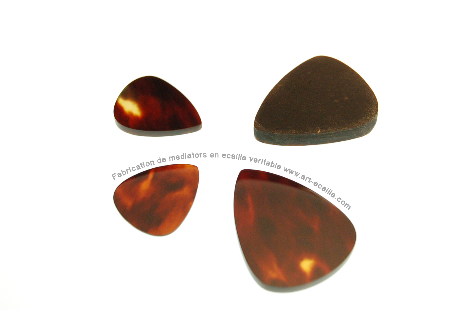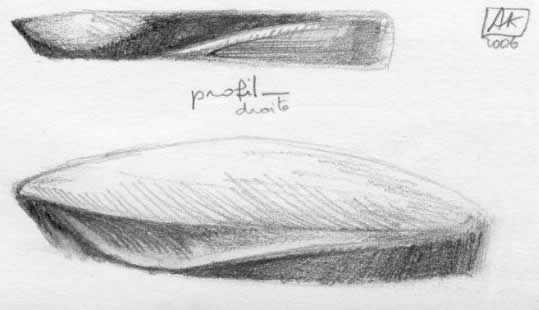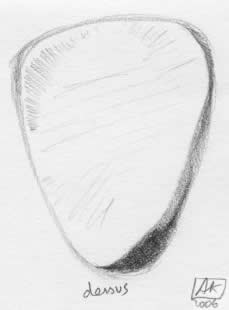Le 28ème Festival Django Reinhardt aura lieu cette année du 28 Juin au 1er Juillet 2007 à Samois, l'atelier de la Maison Bonnet sera présent une fois de plus pour façonner sur place et sur mesure vos médiators en écaille véritable.
. Je dédie cette page à José. Il a beau être au paradis, je suis sûr que ça va le faire sourire.Turtle shell plectrum
It is safe to say that all guitarists practising the music of the great Django Reinhardt make use of exclusively plectrums made of turtle shell, unless of course if this one is not available , then anything but the kitchen think will be used, mostly synthetic material. But if available it will be the most welcome material to play your guitr be it a Semer , a Favino , Busato , Di Mauro or what you may have, turle shell gives its flavor to the sound, warmth as well as clarity and projection, and all subtilities that are there for the pluckin .... And don' be afraid a turtle shell pick will not slow you down any...!!!
Let's be a bit technical
Thickness
To start with a pick should be thick, Django himself used picks as thick as possible. A pick too thin would "give in" as soon as one lean on it, besides it makes quite undesirable string's noise. On the other side of the coin, a thick one will not "give in" and will reflect every aspects of one's touch, that personal thing will come out , every details wll comes out of the guitar , from the whispering cristal clear pianissimo to the savages storm like wild cries the guitar can shout out , passing thru ther dark toned blue notes. The thickness of the point should idealy be around 3 mm , the pick could be thicker where it's holden. ( light trapeozidal form )
The attack point ( contact points )
The most important part of the pick is the one that the string is "reading" , the contact point of the pick. This part will determine the sound, the touch of the pick. This part is the one that rub against the string , prior to the pick leaving it, the profile should be perfect or as near as . Nothing is more annoying than those "ready to play" picks, rounded all over , this makes for only one possible point of contact to the string, resulting in a very thin and almost sick tone .... No one should be contronted with that discease tone .... in any style of music !!!
The contact point of the pick should be flat, all contact are more in control from that ... any curve wil be made while playing the darn thing, so never throw away an old pick, your playing signature is stamped into it ,and it could serves as an example for making another one very quicly. When using the pick avoid playing the same side, turn it form time to time, both sides should worn the same so that up and down picked strokes sound the same if desired. The following picture depcitng the pointy part of the pick careacteristicly reveals the playing of a right handed player .
Point ( or "pointy part )
The thicker the pick , the more the point is "rounded" ( seing from above), if the point was more sharp, it would "stumble " and you will get stuck for no other reasons than having a bad tool . A "pointy" pick will give more brillancy to your sound, more treble, with a more rounded point the rpoduction of tone will be more balanced et wil roll more easily in the strings. To get a more precise and more definition out of the strings the point should be fine ( as seen from the sides of the pick ).
The Model ( form)
Once it is deciced what the contact point that the strings are "reading" are like , the remain of the form of the pick will not possibly affect the sound , but the overal form of it would affect your playing it, one should be able to turn the pick at wil ,also it should be easy to hold firmly when desired , so to say what kind of lenght or width your pick should be is not possible, there is some standard form that accomodate almost everybody, still one should discover for themselves what are the ideal pick measurements that fits them the best, so try a few , after that you should stick to it, the pick is kind of an extension of yourself, much like the guitar ...at least it should. You could ask the masters playing this type of music their opinions, like Fappy Laffertin, Stochelo Rosenberg ,Moreno , Angelo Debarre , Birelli Lagrene , Sebastien Felix and a host of others ( a list, althought being "right" would be exhaustive ... ) on about what and how , chances are that their answer will be about the same, so by all means ask them, but if they are not around, i have put together a small list of tips under.
A few pointers
If the pick is long enough it will not only give a good grip on it, but you will be able to hold it between the second and third joind if needed, it will stay there even if you maltreat it. Both "faces" should be polished, that is the parts that will have contact with the string, the part that are holded should be unpolished, if already polished, you could uses a little flame right under the part you intend to use it ( both faces of the picks of course ) that way it will not move a bit . Althought a very thick pick is favored by much guitarists i avocate the 3, 3,5 mm ones, all kind of colors are possible that way without hammering at the strings , if a "big " sound is needed just turn it sidewise more to the strings , that way the string is reading more "fat" and you get it, the brillacy is at disposal, the other way around, a bid thick pick will give you mostly a very darkened sound, to get the brillancy will only be possible while playing hashly ( who needs that ? one plays for pleasure , not for punishment, ain't it ? ) while the 3,5 mmm gives you that at once pratically on itself and then some ... By all means use all kind of angles to the strings, this will be the case if you are playing rhythm as well, that way a lots of colors and sounds are avalaible . It's a good idea to use some kind of fat on the arts that will contact the strings before you play, i use candle wax , the remains of a romantic evening .... so there is some romantics into the pick already , but for sure your pick will last longer, as a matter of fact, the chance that your pick will get "lost' are greater than you worning the darn thing down in a year time .
The color ....
Other that estetics it does not really influence the sound, but the darken shell seems to be more "dense" , all colors react well and accomodate the playing like no otjher material known to me, that includes some syntetic stuff i was confronted with lately... much string noise to my ears and really the ridiculous price attached to that .... some people will never stop taking on the Django swing money express, but for us musicians /guitarist is the opporptunity to use the kind of material our eldest used is right there , made avalaible by Frank , thanks Frank .
Pictured under is the pick of Micha, the outcome of much playing and experience, look at it , no fancies, simple as can be , yet the ultimate for playing !
Micha



